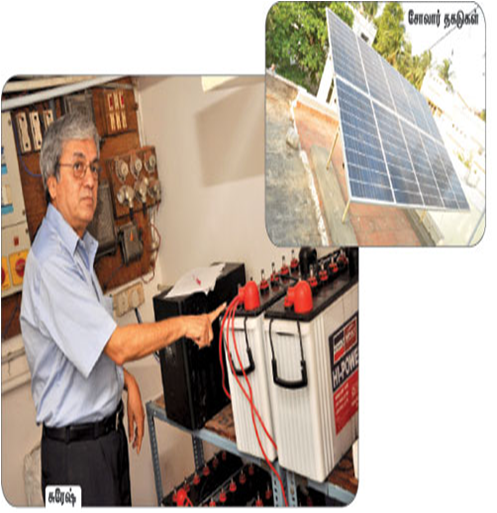
Meet The Man Who Has Built A House That Satisfies All His Needs From Food To Water To Gas
2 Feb 2017 6:15 AM GMT
Editor : Koshika Mira Saxena Mira Saxena
Writer, social worker, book addict, love kids and cooking. Believes in spreading smiles.
Solar power is reshaping energy production around the world. While people are choosing to move to solar power in many countries like China, Japan, Germany, and the United States, Indians are also changing their lifestyle to use solar power as a source of energy.
One such person is Dwarkadas Suresh, popularly known as Solar Suresh. An IIT Madras and IIM Ahmedabad graduate, he lives in Chennai with his wife, son, and daughter-in-law. He has worked in textile marketing industries in various capacities including as the Chief Executive Officer, Managerial Director. He retired in 2015, and is now enjoying his green home.
The Logical Indian spoke to Mr Suresh to know more about his lifestyle, inspiration and challenges.
What was the motivation to shift to solar energy?
I was in Germany and witnessed many rooftop plants there. I thought if a country with a lot less sunshine can install these facilities, then why not implement the same in India which has solar energy in abundance?When I came back, I interacted with a lot of vendors, but no one agreed to install it. It was hard to find a suitable rooftop solar plant vendor and also to get a proper solar inverter. Even big corporates did not show any interest. After some time, I located a local vendor who had the same interest as mine. He manufactured and designed the solar power plant of my home.
What changes have you observed since then?
I installed a rooftop solar plant of 3kW capacity four years ago. I connected one Air Conditioner, Pump, Refrigerator, Fans, Lights, TV, Computer and Laptop, Mixer Grinder and Washing Machine. I have not experienced power cut even for a minute in the last four years except during Cyclone Vardah. There was no electricity for one day.
The electricity charges are saved by producing around 12-16 units a day. There are many other advantages like no daily maintenance. It generates electricity even during mild and rainy days. The major advantage is that solar produces non-polluting power, does not work on fossil fuel and thus saves foreign exchange for the country.
The general idea is that solar plants are expensive, high maintenance, etc. What is your take on this?
It is a one-time investment. Raw material is free for around 20 years, and the process of generating electricity is also free for 20 years during the lifespan of panels. There is an inbuilt insurance from future tariff increase which is certain. For example, the tariff was Rs 3 per unit (beyond 500 units) in 2012 scaling up to Rs 6.60 now, an increase of over 120% in 3 years.
There is no separate wiring required. The standalone rooftop solar plant is a sustainable, affordable, viable project, presently giving over 6 percent tax-free return including battery replacement. With tariff increase, this return on investment will only increase. The installation is also quite simple. It requires a shadow-free area, about 80 sq ft per kW.
What other projects have you started at your home?
Solar panels are reliable sources. I have also installed indoor biogas plant of 1 cubic meter to process around 4 kg organic waste per day, and it produces to about 20 kg of gas per month. There is no daily maintenance. The waste which is generated is converted into two useful resources- cooking gas and organic manure. What can be a better way of garbage management? Installation is also very simple process, and no odour is generated. The entire process is automatic. There is no manual intervention except feeding the plant daily. There is no pollution generated. There are also certain conditions like only organic waste such as cooked or uncooked food, spoilt food, vegetable and fruit peels, etc. can be used as input. The other items like lime, orange, onion, egg shells, bones, ordinary leaves should be avoided.
I also started rainwater harvesting around 20 years ago. Now there are two types of RWH – first is filter and store use and second is recharge groundwater use. In the first case, rainwater is collected and filtered through a simple organic filtration by using pebbles, charcoal and river sand. This water can be used for cooking and drinking purpose.
The second case is when the rainwater accumulates or stagnates, a pipe of 15 feet length and 8-inch diameter with holes every foot is inserted into the ground such that water goes into the pipe and recharges groundwater.
And then again there is no daily maintenance required. Just before the arrival of monsoon season, the terrace space should be cleaned, and organic items like pebbles, charcoal, sand are to be reused and kept tidy.
Apart from these, I have a terrace kitchen garden. Since I was a novice then and had no knowledge about it, I started with five pots and sowed seeds. I watched vegetables like lady’s finger, tomatoes, brinjal growing. Now there are 70 earthen pots, broken plastic buckets and many bags. Organically we have grown about 15 types of vegetables. It is a very pleasant sight to see my garden growing, and the vegetables from the garden are tastier than we get from the market. We do not go to the market to buy groceries, and we just have everything on our terrace.
How does it feel to go green?
Oh, it feels wonderful. In fact, we have created a forest atmosphere. There are growing bamboo plants, creepers to flow over them. When you peep from the terrace, one gets a feeling of being in the forest and not in Kilpauk. I cannot see neighbouring buildings and chaotic traffic. I am surrounded only by greenery.
You can get in touch with him at his email-id [email protected]
 All section
All section














